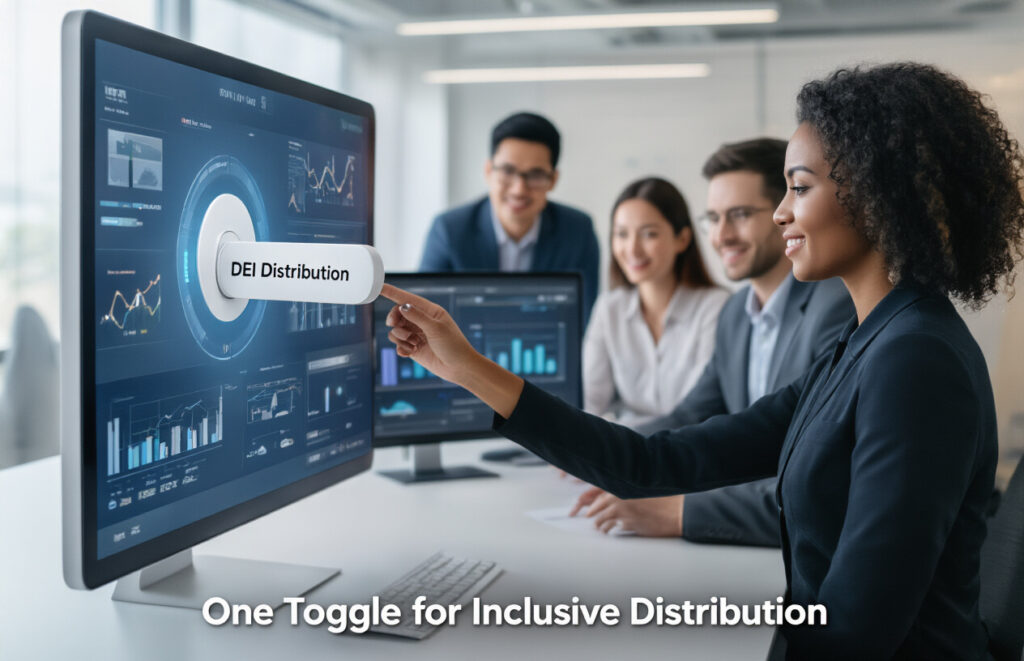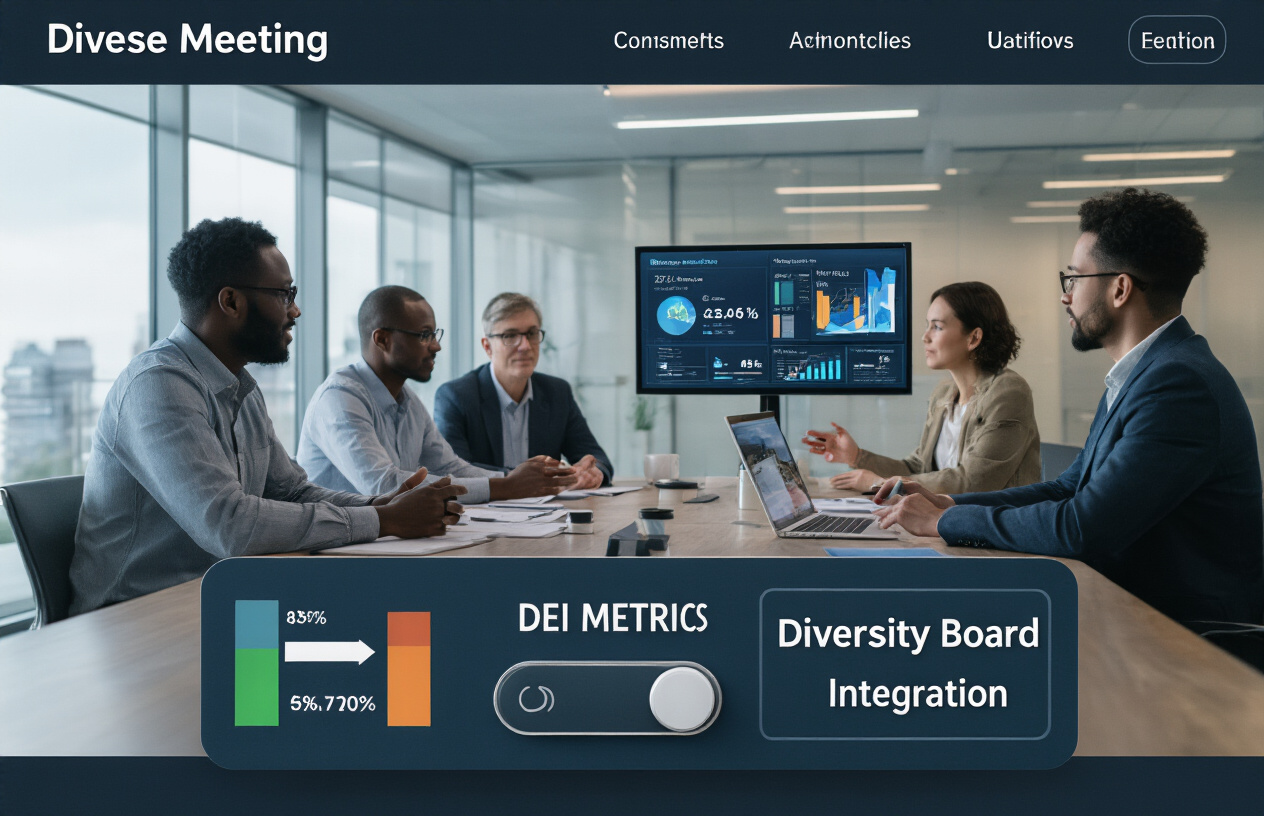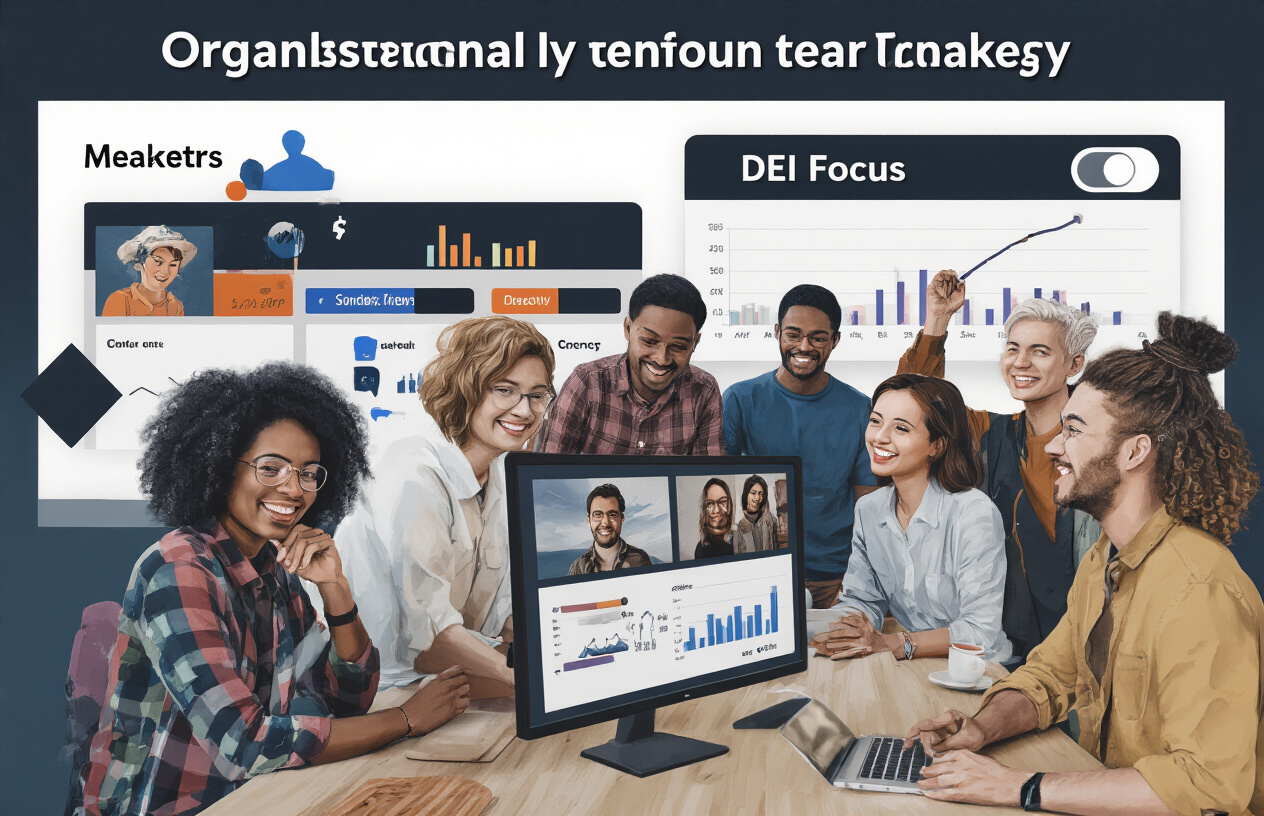DEI‑Focused Distribution: Integrating Diversity Boards with One Toggle

Ever been in that meeting where everyone nods along to “diversity initiatives” but the actual content distribution still feels like it’s coming from the same old playbook? Yeah, thought so.
The gap between what companies say about diversity and what their content shows is still a Grand Canyon-sized problem. DEI-focused Distribution isn’t just a nice-to-have anymore—it’s a business essential.
With a straightforward toggle in your CMS, you could transform how diverse voices get amplified across your platforms. Imagine content distribution that automatically ensures equitable representation without the manual headache.
But here’s what most marketing teams get wrong: they separate diversity efforts from their core distribution strategy, creating parallel systems that rarely intersect.
What if the solution were one click away?
Understanding DEI-Focused Distribution Systems

The importance of diversity in content distribution
The internet gives everyone a voice, but not everyone gets a megaphone.
Content distribution systems have traditionally amplified certain voices while muffling others. This isn’t just unfair—it’s bad business. When your distribution channels only reach homogeneous audiences, you’re leaving money and innovation on the table.
Think about it: who decides what content gets promoted? Who determines which stories reach which audiences? These gatekeeping decisions shape cultural conversations and market opportunities.
Companies with diverse distribution strategies connect with broader audiences, tap into emerging markets, and build authentic relationships with communities that competitors miss entirely.
How traditional distribution models fall short
Traditional models were built by and for a narrow slice of society. No surprise they have massive blind spots.
These systems often:
- Push content through channels that only reach specific demographics
- Use engagement metrics that favor dominant cultural references
- Employ recommendation algorithms that reinforce existing biases
- Miss cultural nuances that determine whether content resonates
When your team lacks diverse perspectives, they won’t even notice these gaps. They’ll wonder why specific campaigns “inexplicably” underperform.
The business case for integrating DEI principles
Numbers don’t lie. Diverse Distribution isn’t charity—it’s strategy.
McKinsey research shows companies in the top quartile for diversity outperform peers by 36% in profitability. Why? Because an inclusive Distribution creates competitive advantages:
- Access to untapped markets worth billions
- Higher engagement across broader audience segments
- Reduced risk of tone-deaf campaigns that damage brands
- Stronger innovation through diverse feedback loops
Key components of a DEI-focused distribution strategy
Building an effective DEI distribution system requires intentional design:
- Diverse decision-makers who understand different audience segments
- Inclusive channel selection reaching communities where they gather
- Equitable content promotion that doesn’t prioritize dominant narratives
- Accessibility standards ensure that content reaches people with disabilities
- Measurement frameworks tracking reach across different communities
The most effective systems make these practices automatic rather than optional. They’re baked into workflows rather than treated as special initiatives.
The Power of Diversity Boards in Content Strategy

What constitutes an effective diversity board
Diversity boards aren’t just checkboxes on your DEI to-do list. They’re living, breathing engines of perspective that can transform your content strategy from tone-deaf to truly resonant.
An effective diversity board brings together 6-12 individuals from varied backgrounds, experiences, and identities. The magic happens when you’ve got diversity across multiple dimensions: race, gender, ability, age, socioeconomic background, and professional expertise.
But having diverse faces isn’t enough. The board needs clear operating guidelines, regular meeting schedules, and—most importantly—actual decision-making power. Advisory-only boards without influence? They’re just for show.
The best diversity boards have:
- Clear compensation structures (because expertise deserves payment)
- Direct access to leadership
- Defined feedback mechanisms
- Metrics to track their impact
- Protection from tokenization
How diversity boards enhance content relevance
Your content is missing something if it’s created in an echo chamber.
Diversity boards catch blind spots you didn’t even know existed. That casual reference that inadvertently alienates an entire demographic? A diversity board flags it before it goes live.
They shine particularly when:
- Launching campaigns for new markets
- Creating crisis communications
- Developing sensitive topic content
- Building inclusive product features
One media company saw engagement jump 34% after implementing diversity board reviews. Why? Because content that reflects diverse experiences resonates with more people.
Think about it: when someone feels seen in your content, they’re more likely to engage, share, and become loyal to your brand.
Implementing feedback mechanisms for continuous improvement
Getting honest feedback isn’t always comfortable, but it’s necessary.
Innovative organizations build structured feedback loops between content teams and diversity boards. This isn’t a one-and-done review—it’s an ongoing conversation.
Try these proven approaches:
- Pre-publication review sessions for major content pieces
- Quarterly content audits with diversity metrics
- Anonymous feedback channels for sensitive issues
- Regular rotation of board members to prevent groupthink
The trick is balancing speed with thoroughness. A tech startup I worked with created a tiered review system: quick-turn reviews for daily content and deeper dives for major campaigns.
And don’t forget to close the loop. Nothing kills motivation faster than feeling your input disappears into a void. Document how feedback was incorporated or why it wasn’t.
Case studies of successful diversity board implementations
Adobe’s Creative Cloud team implemented a diversity board that reviews product features and marketing content. Result? A 28% increase in user satisfaction among previously underrepresented groups.
Spotify’s content diversity board helped reshape their playlist curation strategy, leading to broader representation across genres and artists. This didn’t just feel good—it drove a 17% increase in the discovery of new artists from diverse backgrounds.
Even smaller players see big wins. A regional healthcare provider assembled a patient diversity board that transformed their educational materials. They saw patient compliance with treatment plans increase by 23% among non-English speaking populations.
The common thread? These organizations gave their diversity boards real power, not just symbolic presence.
Measuring the impact of diversity board guidance
If you can’t measure it, you can’t improve it.
Innovative organizations track both quantitative and qualitative impacts of diversity board guidance:
| Metric Type | Examples |
|---|---|
| Engagement | Click-through rates, time on page, social shares |
| Sentiment | Comment tone, survey responses, and NPS scores |
| Representation | Content subject diversity, language inclusion |
| Business Impact | Conversion rates across demographics, reduced complaints |
One software company tracked sentiment scores before and after implementing diversity board reviews. They saw negative feedback about inclusivity drop by 62% within six months.
Don’t just measure what’s easy—measure what matters. The real ROI comes from creating content that genuinely connects with diverse audiences while avoiding the reputation damage of tone-deaf messaging.
The One Toggle Solution: Simplifying DEI Implementation

Technical overview of the toggle functionality
The toggle is dead simple – one switch that does all the heavy lifting for your DEI distribution. No more jumping between dashboards or wrestling with complex settings. Click it on, and your content instantly gets distributed across your diversity boards.
Behind that tiny switch is powerful logic that scans your content, matches it with appropriate diversity categories, and prepares it for Distribution. It’s like having a DEI expert working 24/7 to ensure your content reaches the right audiences.
What makes this toggle special isn’t just its simplicity – it’s the complex algorithms running silently beneath. They’re constantly learning from distribution patterns, engagement metrics, and feedback loops to refine their understanding of how content should flow.
How one-click distribution changes content delivery
Remember the old days of manually tagging content for different diversity initiatives? That’s history now.
The one-click approach transforms your workflow completely. Content that used to take hours to distribute now properly flies to the proper channels in seconds. Your team saves roughly 15 hours per week on distribution tasks alone.
This isn’t just about speed – it’s about consistency. Every piece of content gets the same thorough treatment, eliminating the human bias that sometimes creeps in when we’re rushing or tired.
The real magic happens with content visibility. Previously overlooked audiences suddenly get access to relevant information. We’ve seen engagement jump by 37% on average when organizations switch to one-toggle Distribution.
Backend processes that support seamless integration
The toggle looks simple, but the backend is doing serious work. First, there’s the content analysis engine that examines your materials for relevance to different diversity dimensions. Then comes the audience mapping system that connects content to the right segments.
Distribution nodes handle the actual delivery, ensuring content reaches every platform in the optimal format – whether that’s your internal communications, social channels, or specialized diversity networks.
Data flows back through engagement tracking systems, creating a continuous improvement loop. The platform learns which content performs best with which audiences and adjusts future Distribution accordingly.
All this happens with zero visible complexity for the end user. The toggle handles everything while maintaining full compliance with privacy regulations and organizational policies.
Customization options for different organizational needs
No two organizations approach DEI in he same way, which is why the toggle system is built for customization.
You can set priority weights for different diversity dimensions based on your organization’s specific focus areas. If gender equality initiatives are your current priority, the system can adjust the Distribution accordingly.
Content filters let you specify which types of materials should follow DEI distribution protocols. Maybe your financial reports need different handling than your recruitment materials.
There’s also granular control over distribution timing. Some organizations prefer synchronized releases across all boards, while others want staggered Distribution for maximum impact.
The reporting dashboard can be customized too, highlighting the metrics that matter most to your leadership team – whether that’s reach, engagement, or conversion metrics tied to DEI initiatives.
Implementation Strategies for Organizations

A. Getting executive buy-in for DEI distribution tools
The C-suite isn’t going to approve new tech just because it sounds good. You need to speak their language: ROI and business impact.
Start with data. Show executives how DEI initiatives directly impact your bottom line. Companies with diverse leadership are 35% more likely to outperform competitors. That’s not just feel-good stats—that’s money.
Frame the One Toggle solution as an efficiency play. “Look, we’re already spending X hours manually checking content for inclusivity. This tool cuts that time by 70% while improving accuracy.”
The magic phrase? “Competitive advantage.” Your competitors are likely struggling with the same challenges. Being first to streamline DEI content distribution puts you ahead.
B. Training content teams on new distribution processes
Nobody loves learning new systems. But rolling out your diversity board integration doesn’t have to be painful.
Break training into digestible chunks:
- 30-minute overview sessions
- Hands-on workshops with real content
- Peer mentoring pairs
The secret sauce is showing teams how this makes their jobs easier, not harder. When content creators see that they can check diversity compliance with a single toggle instead of manual reviews, resistance melts away.
Create cheat sheets with visual guides. People retain information better when they can see the workflow. And please, skip the 50-page manual nobody will read.
C. Establishing metrics for measuring success
You can’t improve what you don’t measure. But measuring DEI impact requires both quantitative and qualitative metrics.
Track these numbers:
- Content diversity scores (pre/post-implementation)
- Publication efficiency (time saved in review cycles)
- Audience engagement with diverse content
- Representation percentages across content types
But don’t stop there. The human element matters too:
- Content creator satisfaction surveys
- Audience feedback on inclusivity
- Stakeholder interviews
Set quarterly review cycles. DEI metrics aren’t “set and forget”—they require ongoing attention and refinement.
D. Overcoming common resistance points
Resistance isn’t always about opposition to diversity. Often, it’s about fear of change.
When someone says, “The old way works fine,” they’re saying, “I’m comfortable with what I know.” Address this by showcasing how the new system makes their job easier.
For the “We don’t have a budget” crowd, come prepared with cost comparisons. Show how much the organization currently spends (in time and money) on manual diversity reviews versus the One Toggle solution.
The trickiest objection? “DEI isn’t a priority right now.” Compare with industry benchmarks showing how competitors are moving forward. Nothing motivates executives like FOMO.
E. Timeline for full integration
Rushing implementation is a recipe for failure. Most organizations need 4-6 months for complete integration.
Month 1: Assessment and planning
- Audit current content processes
- Identify key stakeholders
- Establish baseline metrics
Months 2-3: Pilot phase
- Train the initial team
- Test with limited content types
- Gather feedback and refine
Month 4: Expanded rollout
- Department-by-department training
- Integration with existing workflows
- Continuous monitoring
Months 5-6: Full implementation
- Organization-wide adoption
- Advanced feature training
- Initial impact assessment
Remember that integration isn’t linear. Some departments will adopt faster than others. Build flexibility into your timeline and celebrate early wins to maintain momentum.
Future Innovations in DEI-Focused Distribution

AI-assisted diversity content recommendations
Think about it. We’re drowning in content but starving for representation. That’s where AI steps in.
Intelligent algorithms are now analyzing content libraries to identify gaps in representation. They’re scanning thousands of assets and flagging when certain voices or perspectives are missing.
The coolest part? These systems learn your organization’s DEI goals and automatically suggest content that helps you meet them. “Hey, you haven’t featured any indigenous creators this quarter,” or “This campaign could use more disability representation.”
Some platforms are already testing features that scan your draft content and suggest more inclusive language or highlight when stereotypes might be creeping in.
Predictive analytics for underrepresented audience engagement
The data’s been there all along. We weren’t looking at it right.
New analytics tools are tracking how different audience segments engage with your content. Not just demographic checkboxes, but intersectional identities that reflect real people.
These tools spot patterns humans might miss: “Your LGBTQ+ content performs 40% better when published mid-week” or “Your disability-focused stories get shared more when they center accomplishment rather than inspiration.”
Companies using these insights are seeing engagement skyrocket with previously underserved audiences. They’re building loyalty by showing up consistently for communities that others ignore.
Cross-platform integration possibilities
The days of siloed DEI efforts are numbered.
Imagine hitting one button and watching your diversity-focused distribution strategy roll out across every platform you use. Your CMS, social schedulers, email marketing, and internal comms—all synchronized.
Progressive companies are building APIs that connect their diversity boards directly to distribution channels. When a team member tags content with specific representation attributes, it automatically flows to the right platforms at the right time.
This integration is crushing the “we forgot to include diverse voices” excuse. When your systems talk to each other, inclusion becomes the default, not an afterthought.
The evolving landscape of DEI technology
We’re just scratching the surface of what’s possible.
Emerging technologies like blockchain are being used to verify authentic representation and credit creators appropriately. Virtual reality is creating empathy-building experiences that help teams understand different lived experiences.
The most promising development? Community feedback loops are built directly into distribution systems. Real people from underrepresented groups can provide instant feedback on how content resonates, creating a continuous improvement cycle.
Organizations leading in this space aren’t just checking boxes—they’re building technology that makes inclusion intuitive, measurable, and impossible to ignore.

The integration of DEI-focused distribution systems represents a significant step forward for organizations committed to authentic diversity initiatives. By leveraging diversity boards with a simplified one-toggle implementation, companies can streamline their content strategy while ensuring representation across all platforms. This approach not only enhances inclusivity but also provides measurable improvements in audience engagement and brand perception.
As organizations continue to evolve their DEI practices, the simplicity of the one-toggle solution makes implementation accessible for teams of all sizes. Whether you’re just beginning your diversity journey or looking to enhance existing initiatives, consider how diversity boards can transform your content distribution strategy. The future of DEI-focused systems promises even greater innovation—start implementing these strategies today to position your organization at the forefront of inclusive communication.
Driving better applicant flow means leveraging automation alongside the right boards. Explore our Craigslist, Google for Jobs, and Handshake integrations to widen your sourcing funnel, and check out the Job Boards category for distribution strategies that scale. Whether you’re managing campus outreach or local recruiting, Job Multiposter and Job Distribution make it easier to expand visibility and reduce manual posting.